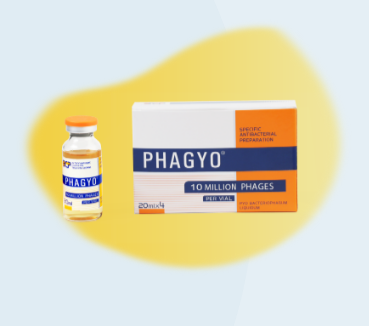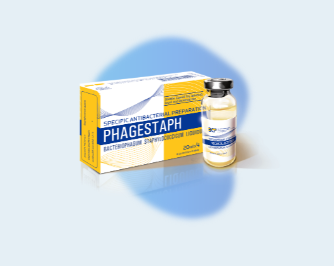


It is used in the treatment of purulent inflammatory disease, for prevention
Trade name: Fagio ®
International Non-proprietary Name:
Pio bacteriophage liquid
Pyo Bacteriophagum Liquidum
Description:
A transparent liquid of varying intensity yellow color with a specific taste.
Composition:
Active ingredient
A mixture of sterile filtrates of phagolysates of bacteria: Streptococcus, Staphylococcus, E.Coli, Pseudomonas aeruginosa, Proteus
Quantitative composition: 1 ml of the drug contains specific phages:
Bacteriophage Streptococcus,
Bacteriophagum Staphylococcus,
Bacteriophage E.Coli,
Bacteriophagum Pseudomonas aeruginosa,
Bacteriophage Proteus,
Each individual has a quantity of at least –10 5
Pharmaceutical form:
20 ml sterile solution for oral administration (per os, per rectum), local and external use.
Pharmacotherapeutic group:
Specific antibacterial drug.
Pharmacological action
A bacteriophage is a bacteria-specific virus that adsorbs to the cell membrane of a homologous bacterium, disrupts its integrity, penetrates the cell, multiplies, and causes its lysis.
Fagio contains only virulent phages selected from bacteria (Streptococcus, Staphylococcus, E.Coli, Pseudomonas aeruginosa, Proteus), which ensures the guaranteed high activity and effectiveness of the drug. Regardless of the route of administration, bacteriophage preparations are quickly absorbed into the blood and lymph and easily reach the focus of the disease. Excreted from the body: the main part is excreted through the kidneys, which sanitize the urinary tract, the rest - through the gastrointestinal tract.
Therapeutic indications:
Fagio is used for the prevention and treatment of purulent diseases caused by bacteria (Streptococcus, Staphylococcus, E.Coli, Pseudomonas aeruginosa, Proteus) in patients of all age groups and high-risk groups.
The drug is used for the treatment of:
– Bacterial infections of the upper and lower respiratory tract (inflammation of the nasal cavity and sinuses, inflammation of the middle ear, tonsillitis, laryngitis, pharyngitis, tracheitis, bronchitis, pneumonia, pleurisy);
– In surgical practice: for the treatment of purulent wounds, burns, abscesses, phlegmons, furuncles, carbuncles, hydradenitis, panaritium, paraproctitis, mastitis, bursitis, osteomyelitis;
– in urological practice for urogenital diseases (urethritis, cystitis, pyelonephritis, colpitis, endometritis, salpingoophoritis);
– For the treatment of diseases of the digestive system (enteric infections, gastroenterocolitis, cholecystitis, irritable bowel syndrome (dysbacteriosis));
– during sepsis;
– In purulent-inflammatory diseases of newborns (omphalitis, pyoderma, sepsis);
– In other diseases caused by the microorganisms mentioned above.
For the purpose of prophylaxis, the drug is used:
– for treating fresh wounds, both in stationary and household conditions;
– For the prevention of purulent complications during surgical manipulations and operations;
– For the prevention of purulent complications of acute respiratory viral infections;
– For the prevention of bacterial contamination and nosocomial infections in medical institutions.
Contraindications:
Hypersensitivity to any component of the vial contents.
Special warnings:
The vial with the drug should be shaken before use. The contents of the vial should be clear and free of sediment.
The drug should not be taken in a cloudy state!
If 20 ml of the drug is not taken at once, it is recommended to remove the contents from the vial with a sterile syringe.
The drug should not be frozen!
Interaction with other medicinal products
Incompatibility of the drug with other medicinal products has not been established. It can be used in combination with other medicinal products in complex treatment, including antibacterial drugs (antibiotics).
Pregnancy and lactation: The drug can be used during pregnancy and lactation.
Effects on ability to drive and use machines:
Taking the drug does not affect the ability to drive or use machines.
Keep out of reach of children!
Dosage, method of administration and method of administration
One of the important prerequisites for the effectiveness of phage therapy is the determination of the sensitivity of the disease-causing microorganism to the phage (phages contained in the preparation). The preparation is especially effective when used in the early stages of the disease and in the case of direct exposure to the focus of infection.
Fagio is prescribed for oral administration (drinking, rectally), topically (for use in the form of ointments, dressings and/or tampons), and for intracavity administration (wounds, abscesses, pleural cavity, joints, nose and nasal adnexa, ear, bladder, vagina-uterus).
For the treatment of purulent-inflammatory processes with local lesions, the drug is prescribed simultaneously, both locally and orally (orally). The treatment period lasts an average of 5-10 days.
Dosage is determined by the size and/or volume of the affected area. The drug is injected into the infected cavity after it has been emptied of pus and drained. The amount of drug administered should be relatively less than the amount of pus removed. In the following days, the drug is injected into the cavity through the drainage, the procedure is performed once a day for 3-5 days.
– For the treatment of cystitis, pyelonephritis, urethritis: if the bladder cavity and/or the renal pelvis cavity are drained, the drug is administered 2 times a day: 20-30 ml into the bladder and 5-10 ml into the renal pelvis;
– In case of purulent-inflammatory gynecological diseases, the drug is injected into the vagina and uterine cavity in an amount of 5-10 ml, once a day;
– In purulent-inflammatory diseases of the ENT: 2 to 10 ml of the drug is used, instilled into the corresponding cavity 1-3 times, rinsed, rinsed, a soaked turunda is placed in the cavity for 1 hour. For the treatment of purulent tonsillitis, the drug is prescribed both as a solution and orally;
– For stomatitis and chronic generalized periodontitis: 10-20 ml of the drug is used for rinsing the mouth 3-4 times a day, as well as in the form of a soaked turund in periodontal pockets, for 5-10 minutes;
In case of enteric pathologies: treatment of diseases of the gastrointestinal tract, irritable bowel syndrome, caused by the above microorganisms or their combination, is carried out according to the general scheme for oral administration (per os) 1 hour before meals 1-3 times a day. With nausea: therapeutic micro-nausea - once, in the evening, before bedtime.
It is recommended to carry out treatment according to the scheme below:
|
Age |
For drinking (per os) |
Rectally (Per rectum) |
|
Up to 6 months |
5 ml – once a day |
10 ml – once a day |
|
From 6 months to 1 year |
5 ml – 2 times a day |
10 ml – once a day |
|
From 1 year to 3 years |
5 ml – 3 times a day |
20 ml – once a day |
|
From 3 to 8 years old |
10 ml – 2-3 times a day |
30 ml – once a day |
|
Over 8 years old |
20 ml – 2-3 times a day |
40 ml – once a day |
Note: If chemical antiseptics were used to treat the wound and/or cavity, the corresponding areas should be treated with sterile 0.9% saline solution before applying the drug.
Overdose
Data on the consequences of overdose of bacteriophage preparations are not known.
Side effects
The drug is non-toxic, and no data have been identified on side effects or harmful effects on the human body after its use.
Release form and packaging
Fagio is produced in 20 ml vials of medical glass. A cardboard box contains 4 20 ml vials of the drug along with instructions for use.
Storage and transportation conditions:
Store in a dry place protected from light. At a temperature of 2°С – 25°С.
Transportation is possible at temperatures ranging from 2°С to 25°С, using all types of closed transport that ensure a stable temperature regime is maintained throughout the transportation period.
Shelf life, expiration date:
When stored under proper conditions, the drug is valid for 2 years from the date of manufacture indicated on the packaging. The drug should not be used after the expiration date. Do not use a cloudy drug.
Dispensing mode:
Over-the-counter.